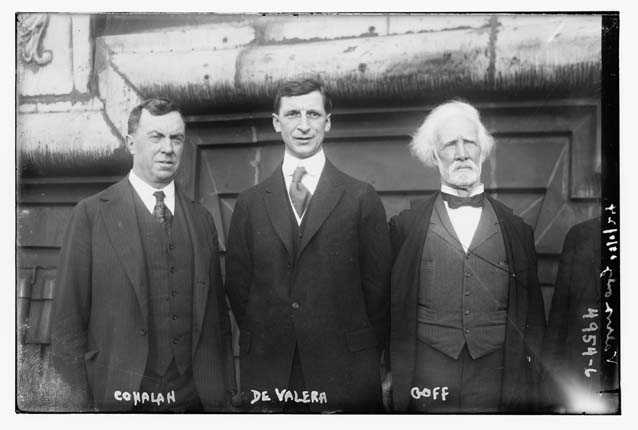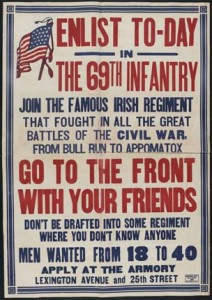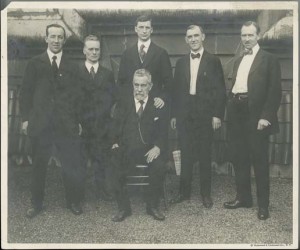‘The Judge’ versus ‘the Chief’— Daniel Cohalan and the 1920 split within Irish America
Published in Features, Issue 2 (March/April 2015), Volume 23
Judge Daniel Cohalan, Éamon de Valera and another member of the Friends of Irish Freedom (FOIF) leadership, Judge John Goff. Photograph taken on the roof of the Waldorf Astoria Hotel, 23 June 1919, shortly after the arrival of de Valera in the United States. (Library of Congress)
‘We have been reluctantly compelled to sever our connections between Clan na Gael and the parent body in Ireland [IRB] until such time as the will of the members of the executive becomes operative and not the will of Justice Cohalan.’
News of the split in Irish America was not well received in Ireland, then suffering the terrors of the Anglo-Irish war. Many Irish nationalists in Ireland blamed Daniel Cohalan for the dispute. In colourful language, Bishop Michael Fogarty of Killaloe, in a letter to a fellow bishop in New York, wrote:
‘One of Ireland’s greatest afflictions at this moment is the behaviour of the Cohalan group in America. It is all dished up here in the daily papers to break the poor people’s hearts. What a time they have chosen, these Friends of Irish Freedom, to round on us. We are being dragooned and shot like wild animals.’
Not simply Irish-Americans vs Irish
It is important to note that the split was not simply one between Irish-Americans and Irish nationalists from Ireland. De Valera had the support of the Clan leader in Philadelphia, Joe McGarrity, as well as other prominent Irish-Americans, such as Frank Walsh. Soon after the split, the American Association for the Recognition of the Irish Republic (AARIR), representing Irish-Americans who supported de Valera, was founded, though its existence was short-lived. Meanwhile, Cohalan had the loyal support of the old Fenian and Clan leader John Devoy and even of some recent Irish republican exiles such as Cork-born Diarmuid Lynch, who had fought in the 1916 Rising and had become national secretary of the Friends in 1918. A majority of the FOIF national council and of the Clan executive remained loyal to Cohalan and Devoy after the split.

First World War recruitment poster for New York’s ‘Fighting 69th’ Infantry Regiment. After US entry into the war on Britain’s side in April 1917, the FOIF adopted a low profile. (Library of Congress)
The Irish Treaty divide and subsequent civil war added fresh complexity to the dispute. Cohalan, Devoy’s Clan and the FOIF supported the Treaty and this won them the support of the pro-Treaty faction within Sinn Féin. The new Irish Free State government saw Cohalan as an influential figure in political circles in the US and, in a foretaste of later Irish government efforts on behalf of the Irish diaspora, enlisted Cohalan’s help in its quest to expand the Irish quota in the American immigration restriction bill of 1924. Cohalan’s papers at the American Irish Historical Society in New York contain much relevant correspondence between Cohalan and Irish government leader W.T. Cosgrave in this regard.
It would therefore be easy to argue that the split within the Irish movement in America was caused by a clash of personalities. Both Cohalan and de Valera were strong-willed and each felt best placed to determine how the interests of Ireland could be served in the United States. De Valera has lent credence to this view in his reports to Dublin. As early as February 1920, eight months before the split, de Valera wrote to Arthur Griffith:
‘The trouble is purely one of personalities. I cannot feel confidence enough in a certain man [Judge Cohalan] to let him have implicit control of tactics here, without consultation and agreement with me.’
This view of the dispute would later be summed up in de Valera’s famous remark about his dealings with Cohalan on his American mission: ‘Big as the country is, it was not big enough to hold the judge and myself’.
Not just a personality clash

(left to right) Harry Boland, Liam Mellows, Éamon de Valera, John Devoy (seated), Dr Patrick McCartan and Diarmuid Lynch. Photograph taken on the roof of the Waldorf Astoria, 23 June 1919. (UCD Archives)
Cohalan’s American political connections made him well suited to his acknowledged role as ‘leader of the Irish race in America’. In the early years of the twentieth century, he was a leading figure in New York Democratic politics and was prominent at the Democratic national conventions in Denver in 1908 and Baltimore in 1912. He was also adviser to the Democratic city boss, Charles F. Murphy, which undoubtedly influenced his appointment to the New York State supreme court in 1911. His nickname, ‘the Judge’, was used by friend and foe alike, and none doubted his remarkable influence over Irish-American affairs in the early years of the twentieth century.
Cohalan’s sense of Irish nationalism was very much coloured by his American upbringing and by his vision of what America should represent. By the end of the nineteenth century, the Irish in America had made much social progress, as illustrated by Cohalan’s own career. Yet some élite sections of American society still viewed the Irish negatively. Many leading American journals, such as The Outlook and Harper’s Magazine, portrayed the Irish as prone to violence and political corruption. In popular discourse, the Anglo-Saxon contribution to the founding of the American nation was celebrated as providing the United States with the ‘instinct of freedom and spirit of liberty’. Meanwhile, the Irish were associated with the corruption of Tammany Hall.
American Irish Historical Society
In trying to combat such perceptions, Cohalan took an active role in the American Irish Historical Society (AIHS), whose objective was to correct the ‘neglect and misrepresentation by certain historians’ of the part the Irish played in the founding of the American nation. This was no academic exercise. In his many speeches and publications, Cohalan drew on heroic narratives of the Irish role in America’s history to enlist mainstream American support for Ireland’s nationalist struggle. Cohalan believed that making the US a more tolerant place for Irish America and enhancing its social and political power would not only benefit Irish America but would be beneficial to Ireland. In turn, the Irish in America needed to demonstrate their loyalty to the American nation while still cultivating a distinct Irish-American identity. This view of the Irish question was shared by many Irish-Americans and by some Irish in the US. Diarmuid Lynch began his manuscript history of the FOIF, now in the National Library of Ireland, with a quotation from John Boyle O’Reilly, a one-time radical Fenian who later became editor of the Boston Pilot: ‘We can do Ireland more good by our Americanism than by our Irishism’.
From Cohalan’s point of view, an Anglo-Saxon élite seemed to be gaining influence in America in the early twentieth century, as social, political and cultural ties between Britain and the US increased. His desire to combat this British threat to America and Irish America influenced much of Cohalan’s nationalist activities. In 1903 Cohalan is listed as president of the board of directors of the influential Irish-American newspaper The Gaelic American. This newspaper, edited by John Devoy, is a useful barometer on Irish-American opposition to ‘Anglo-Saxonism’ in the early twentieth century. The editorial of the first edition warned that ‘a clique of pro-British sycophants’ was seeking to gain control over the direction of American foreign policy. Many of the articles, drawing on the work of the AIHS, glorified the Irish role in the colonial settlement, particularly Irish service in the revolutionary war against Britain. Meanwhile, in the years before the First World War, the paper campaigned fiercely against proposed treaties aimed at arbitrating territorial disputes between the United States and Britain.
American neutrality
Cohalan drew on the resources of the FOIF in a campaign to preserve American neutrality during the First World War, which, according to Cohalan, would mean a British stranglehold over the conduct of American foreign policy. After US entry into the war in April 1917 on Britain’s side, however, the FOIF adopted a low profile. This led to disputes with Sinn Féin representatives in the United States, such as Liam Mellows, who complained about the organisation’s inactivity. Yet Cohalan, who had always trumpeted the heroic Irish role in American conflicts in the past, believed that to continue its attack on Britain would only be exploited by Anglo-Saxon elements in the US out to discredit Irish-American loyalty to the United States.
After the war, under Cohalan’s leadership and under the stewardship of its new national secretary, Diarmuid Lynch, a ‘Victory Fund’ was established which raised over a million dollars. Some of these monies helped to fund an Irish-American ‘commission’ led by Frank Walsh to the post-war Paris peace conference. Although the commission did not get a hearing, it did much to publicise the Irish cause in the United States. Funds from the Victory Fund were also used to support de Valera’s mission to the United States and helped set up de Valera’s bond certificate drive. Lynch passed on the FOIF membership list to the bond drive committee, and many FOIF branches participated actively in promoting the drive despite de Valera’s insistence that it remain under his control.
De Valera’s insistence on controlling bond drive funds caused tension with Cohalan. This was in part influenced, however, by de Valera’s dissatisfaction with Cohalan’s use of the FOIF’s funds and resources to battle Woodrow Wilson’s plan for a League of Nations. For Cohalan, the League was yet another British plot to entangle the United States in an alliance for the preservation of the British Empire, and the FOIF campaign against it was perfectly compatible with Cohalan’s pre-war campaigns to prevent any US-entangling alliance with Britain. De Valera, meanwhile, maintained an open mind on the League, believing that it could be beneficial to an independent Ireland. Such tensions were thus shaped by a clash over what Cohalan perceived as the interests of Irish America and what de Valera perceived as the interests of Ireland.
Michael Doorley is the author of Irish-American diaspora nationalism: the Friends of Irish Freedom, 1916–1935 (Four Courts Press, 2005).
Read More:Reasons for the split
Cohalan’s background
Further reading
J.R. Barrett, The Irish way: becoming American in the multiethnic city (New York, 2013).
M. Doorley, ‘Judge Daniel Cohalan: American Irish nationalist and crusader against British influence in American life’, New Hibernia Review 19 (2) (Summer 2015).
M.P. Guterl, The color of race in America, 1900–1940 (Cambridge, Mass., 2001).
E. McGough, Diarmuid Lynch, a forgotten Irish patriot (Cork, 2013).
















